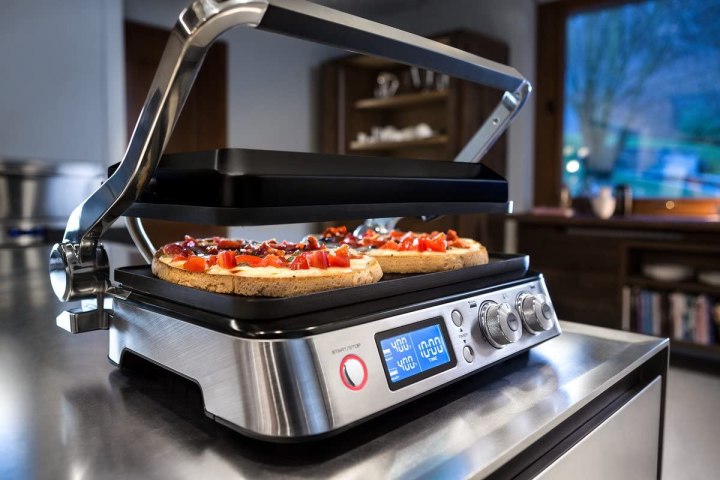Is it time for more delicious grilled dishes around your home? Then you have an important choice to make: Do you need an indoor grill or an outdoor grill? While both are called grills, these are actually very different kinds of cooking appliances. An indoor grill is a smaller device designed to sit on a counter or table without producing smoke, while an outdoor grill is a larger piece of equipment made to stand on its own and frequently requires a fuel source.
We’re taking a full look at their differences and which is right for your cooking needs.
How will the grill fit with your home?

Let’s start with a basic question: What does your home look like? Outdoor grills need plenty of space to be set up and often require a level surface like a deck or patio. Even smaller charcoal grills should be set up on gravel and away from flammable materials. If you don’t have any spots where an outdoor grill can fit, then it’s not a great option. Also, keep in mind that most apartment and housing guidelines technically ban uncovered outdoor grills from balconies due to the fire hazard. If that’s the case, then it’s likely going to be an indoor grill for you.
Weather permitting
What season will you be doing most of your grilling? Rain, snow, and wind are horrible companions for a grilling session. There are good reasons why most outdoor grilling is done in summer or during particularly mild weather. If you and your stomach have a deep desire to grill during a rainy, cold season, then it may be best to get an indoor grill. There’s nothing to keep you from having both an indoor and outdoor grill and switching between them based on the season!
Grilling space and parties

One of the biggest limitations of indoor grills is their size. Even the largest models don’t go much beyond 240 square inches, which is much, much smaller than the average size of an outdoor gas grill or Traeger. If you’re only cooking for one or two people, this isn’t a big deal. If you are cooking for a larger family or party and working on multiple dishes, it’s going to take some time. If you want to hold a party with a whole group of people, an indoor grill isn’t the best choice unless you’re only using it to roast a few appetizers or veggies.
Oh, and a quick note about your oven range: A number of modern oven ranges come with an option to convert them into a griddle with the right accessories. This feature often offers more space than an indoor grill and may be a better alternative for some users.
Fuel and flavor
All right, it’s time to talk about flavor. Here again, we run into a major difference: Indoor grills are electric options designed to be safe to use inside and avoid triggering fire alarms (although you’ll still want to use them in a well-ventilated area). They can char meat a little if you like that — the same way pan-frying a steak can — but they won’t sear meat in quite the same manner as an outdoor grill. Top temperatures tend to max out around 450 to 500 degrees Fahrenheit on most models, although some push higher.
Thanks to their fuel sources, outdoor grills also have additional flavor options. Charcoal can provide its own smoky layer to the food flavors. Grillers can use dampened wood chips from a variety to add even more flavor to longer-cooking ingredients. These options don’t really exist for indoor grills without some extra work like a broiling phase with a wood plank or other steps.
Versatility and food variety

An outdoor grill may offer a number of grilling surfaces for slower or faster cooking times, or for dividing surfaces among different ingredients (steak versus grilled bell pepper versus charring pineapple slices, etc.). Some even have warming boxes and other features. But they generally can’t compete with the cooking versatility of an indoor grill.
Check out our list of the top indoor grills and you’ll see options that can cook pancakes, handle waffles, switch to a panini mode for roasting your sandwiches, and provide grilling surfaces that can handle scrambled eggs and hash browns. That can make indoor grills useful for a wider variety of meals.
Safety considerations
You can’t bring an outdoor grill inside to use. They need constant airflow and produce smoke and carbon monoxide. Indoor grills are about as safe to use as your oven range, although you will want to make sure to place it on an appropriate surface where the risk of overheating is low.
Costs and affordability
Indoor grills can range from around $100 to $200 depending on the type. The cheapest outdoor grills start low too, around $100 to $150 for base models, but quickly rise in price until common gas grills are several hundred dollars or more. Generally, an indoor grill is a better way to save more money and something you can use year-round if you live in an area with changing climate.
Editors' Recommendations
- Can you use a Blink Outdoor Camera without a subscription?
- Should you buy a smart robot mop? Pros and cons
- Smart light bulb buying guide
- ADT Home Security vs. Blue by ADT: What’s the difference?




